Hundred-Watt Implantable TEG Module for Large-Scale Exhaust Gas Waste Heat Recovery
Abstract
:1. Introduction
2. Test Stand and TEG
2.1. Test Stand Build
- Set the inlet flue gas temperature and velocity by adjusting the parameters of the hot air blower.
- Set the cooling water temperature and flow rate through controlling the chiller parameters and cutoff valve.
- When the desired flue gas temperature and cooling water temperature are reached, stabilize for 10 min to ensure uniform TEG temperature.
- Test the TEG’s voltage, current, and other parameters.
- After completing the tests, turn off the hot air blower’s heating element. Once the flue gas temperature has dropped to room temperature, proceed to turn off all the equipment.
2.2. TEG Design
- We set the fin thickness to 1 mm, following the design of traditional heat exchangers.
- The temperature conditions are as outlined below: Inlet flue gas temperature is 130 °C, flue gas flow velocity is 1.8 m/s, and cooling water temperature is 20 °C. This represents one operating condition of flue gas waste heat.
- The contact thermal resistance has a certain impact on the heat transfer between the TEG’s hot side and the flue gas [29]. We use simulations only to confirm the approximate size range of the fins. In this scenario, the influence of the contact thermal resistance is minimal. Therefore, during simulations, we are disregarding the contact thermal resistance.
- We performed a parametric scan for the fin height and spacing, with the height ranging from 25 mm to 55 mm in 10 mm increments, and the spacing ranging from 2 mm to 10 mm in 2 mm increments.
- The temperature difference at both ends of the TEM serves as the criterion for evaluation, with higher temperature differences indicating more favorable fin parameters.
3. Results and Discussion
4. Conclusions
Author Contributions
Funding
Data Availability Statement
Conflicts of Interest
Nomenclature
| TEG | Thermoelectric generator |
| TEM | Thermoelectric module |
| Qin | Thermal energy flow through the TEG |
| Qe | Electrical energy generated by the TEG |
| Qw | Thermal energy recovered by the cooling water |
| Pin | Thermal power through the TEG |
| Pe | Electrical power generated by the TEG |
| Pw | Thermal power recovered by the cooling water |
| q | The flow rate of the cooling water |
| ΔH | The enthalpy difference of cooling water between the inlet and outlet |
| t | Unit time with value for 1 s |
| η | Conversion efficiency of the TEG |
References
- Lee, C.; Yu, B.; Lee, S. An analysis of the thermodynamic efficiency for exhaust gas recirculation-condensed water recirculation-waste heat recovery condensing boilers. Energy 2015, 86, 267–275. [Google Scholar] [CrossRef]
- Oyedepo, S.O.; Fakeye, B.A. Waste heat recovery technologies: Pathway to sustainable energy development. J. Therm. Eng. 2021, 7, 324–348. [Google Scholar] [CrossRef]
- Remeli, M.F.; Tan, L.; Date, A.; Singh, B.; Akbarzadeh, A. Simultaneous power generation and heat recovery using a heat pipe assisted thermoelectric generator system. Energy Convers. Manag. 2015, 91, 110–119. [Google Scholar] [CrossRef]
- Attar, A.; Lee, H.; Weera, S. Experimental Validation of the Optimum Design of an Automotive Air–to–Air Thermoelectric Air Conditioner (TEAC). J. Electron. Mater. 2015, 44, 2177–2185. [Google Scholar] [CrossRef]
- Sakdanuphab, R.; Sakulkalavek, A. Design, empirical modeling and analysis of a waste–heat recovery system coupled to a traditional cooking stove. Energy Convers. Manag. 2017, 139, 182–193. [Google Scholar] [CrossRef]
- Campana, F.; Bianchi, M.; Branchini, L.; De Pascale, A.; Peretto, A.; Baresi, M.; Fermi, A.; Rosetti, N.; Vescovo, R. ORC waste heat recovery in European energy intensive industries: Energy & GHG savings. Energy Convers. Manag. 2013, 76, 244–252. [Google Scholar]
- Men, F.; Chen, L.; Feng, Y.; Xiong, B. Thermoelectric generator for industrial gas phase waste heat recovery. Energy 2017, 135, 83–90. [Google Scholar]
- Angeline, A.A.; Asirvatham, L.G.; Hemanth, D.J.; Jayakumar, J.; Wongwises, S. Performance prediction of hybrid thermoelectric generator with high accuracy using artificial neural networks. Sustain. Energy Technol. Assess. 2019, 33, 53–60. [Google Scholar] [CrossRef]
- Yu, S.H.; Du, Q.; Diao, H.; Shu, G.Q.; Jiao, K. Effect of vehicle driving conditions on the performance of thermoelectric generator. Energy Convers. Manag. 2015, 96, 363–376. [Google Scholar] [CrossRef]
- Stijepovic, M.Z.; Linke, P. Optimal waste heat recovery and reuse in industrial zones. Energy 2011, 13, 341–363. [Google Scholar]
- Miró, L.; Brückner, S.; Cabeza, L.F. Mapping and discussing Industrial Waste Heat (IWH) potentials for different countries. Renew. Sustain. Energy Rev. 2015, 51, 847–855. [Google Scholar] [CrossRef]
- Suter, C.; Jovanovic, Z.R.; Steinfeld, A. A 1kWe thermoelectric stack for geothermal power generation–Modeling and geometrical optimization. Appl. Energy 2012, 99, 379–385. [Google Scholar] [CrossRef]
- Weng, C.-C.; Huang, M.-J. A study of using a thermoelectric generator to harvest energy from a table lamp. Energy 2014, 76, 788–798. [Google Scholar] [CrossRef]
- Özdemir, A.E.; Köysal, Y.; Özbas, E.; Atalay, T. The experimental design of solar heating thermoelectric generator with wind cooling chimney. Energy Convers. Manag. 2015, 98, 127–133. [Google Scholar] [CrossRef]
- Al-Nimr, M.d.A.; Tashtoush, B.M.; Jaradat, A.A. Modeling and simulation of thermoelectric device working as a heat pump and an electric generator under Mediterranean climate. Energy 2015, 90, 1239–1250. [Google Scholar] [CrossRef]
- Xiao, D.; Sun, P.; Wu, J.; Zhang, Y.; Wu, J.; Liu, G.; Hu, H.; Hu, J.; Tan, X.; He, S. Thermoelectric Generator Design and Characterization for Industrial Pipe Waste Heat Recovery. Processes 2023, 11, 1714. [Google Scholar] [CrossRef]
- Orr, B.; Akbarzadeh, A.; Mochizuki, M.; Singh, R. A review of car waste heat recovery systems utilizing thermoelectric generators and heat pipes. Appl. Therm. Eng. 2016, 101, 490–505. [Google Scholar] [CrossRef]
- Kim, T.Y.; Negash, A.A.; Cho, G. Experimental study of energy utilization effectiveness of thermoelectric generator on diesel engine. Energy 2017, 128, 531–539. [Google Scholar] [CrossRef]
- Jaziri, N.; Boughamoura, A.; Müller, J.; Mezghani, B.; Tounsi, F.; Ismail, M. A comprehensive review of Thermoelectric Generators: Technologies and common applications. Energy Rep. 2020, 6, 264–287. [Google Scholar] [CrossRef]
- Kim, T.; Kwak, J.; Kim, B. Energy harvesting performance of hexagonal shaped thermoelectric generator for passenger vehicle applications: An experimental approach. Energy Convers. Manag. 2018, 160, 14–21. [Google Scholar] [CrossRef]
- Goncalves, L.M.; Martins, J.; Antunes, J.; Rocha, R.; Brito, F.P. Heat-pipe assisted thermoelectric generators for exhaust gas applications. ASME Int. Mech. Eng. Congr. Expo. 2010, 5, 1387–1396. [Google Scholar]
- Brito, F.P.; Martins, J.; Hançer, E.; Antunes, N.; Gonçalves, L.M. Thermoelectric exhaust heat recovery with heat pipe-based thermal control. J. Electron. Mater. 2015, 44, 1984–1997. [Google Scholar] [CrossRef]
- Martins, J.; Goncalves, L.M.; Antunes, J.; Brito, F.P. Thermoelectric Exhaust Energy Recovery with Temperature Control through Heat Pipes; SAE Technical Paper; SAE: Warrendale, PA, USA, 2011. [Google Scholar]
- LaGrandeur, J.; Crane, D.; Hung, S.; Mazar, B.; Eder, A. Automotive waste heat conversion to electric power using skutterudite, TAGS, PbTe and BiTe. In Proceedings of the 25th International Conference on Thermoelectrics, Vienna, Austria, 6–10 August 2006; pp. 343–348. [Google Scholar]
- Hussain, Q.E.; Brigham, D.R.; Maranville, C.W. Thermoelectric exhaust heat recovery for hybrid vehicles. SAE Int. J. Engines. 2009, 2, 1132–1142. [Google Scholar] [CrossRef]
- Mori, M.; Yamagami, T.; Sorazawa, M.; Miyabe, T.; Takahashi, S.; Haraguchi, T. Simulation of fuel economy effectiveness of exhaust heat recovery system using thermoelectric generator in a series hybrid. SAE Int. J. Mater. Manuf. 2011, 4, 1268–1276. [Google Scholar] [CrossRef]
- Li, G.; Yin, J.; Zheng, Y.; Guo, W.; Tan, Y.; Ye, C. Analytical design model for waste heat thermoelectric generator and experimental verification. Energy Convers. Manag. 2022, 252, 115034. [Google Scholar] [CrossRef]
- Saha, M.; Tregenza, O.; Twelftree, J.; Hulston, C. A review of thermoelectric generators for waste heat recovery in marine applications. Sustain. Energy Technol. Assess. 2023, 59, 103394. [Google Scholar] [CrossRef]
- Tregenza, O.; Saha, M.; Hutasoit, N.; Hulston, C. An experimental evaluation of the thermal interface resistance between cold sprayed copper/ laser-textured alumina bi-layered composites. Int. J. Heat Mass Transfer. 2022, 188, 122606. [Google Scholar] [CrossRef]

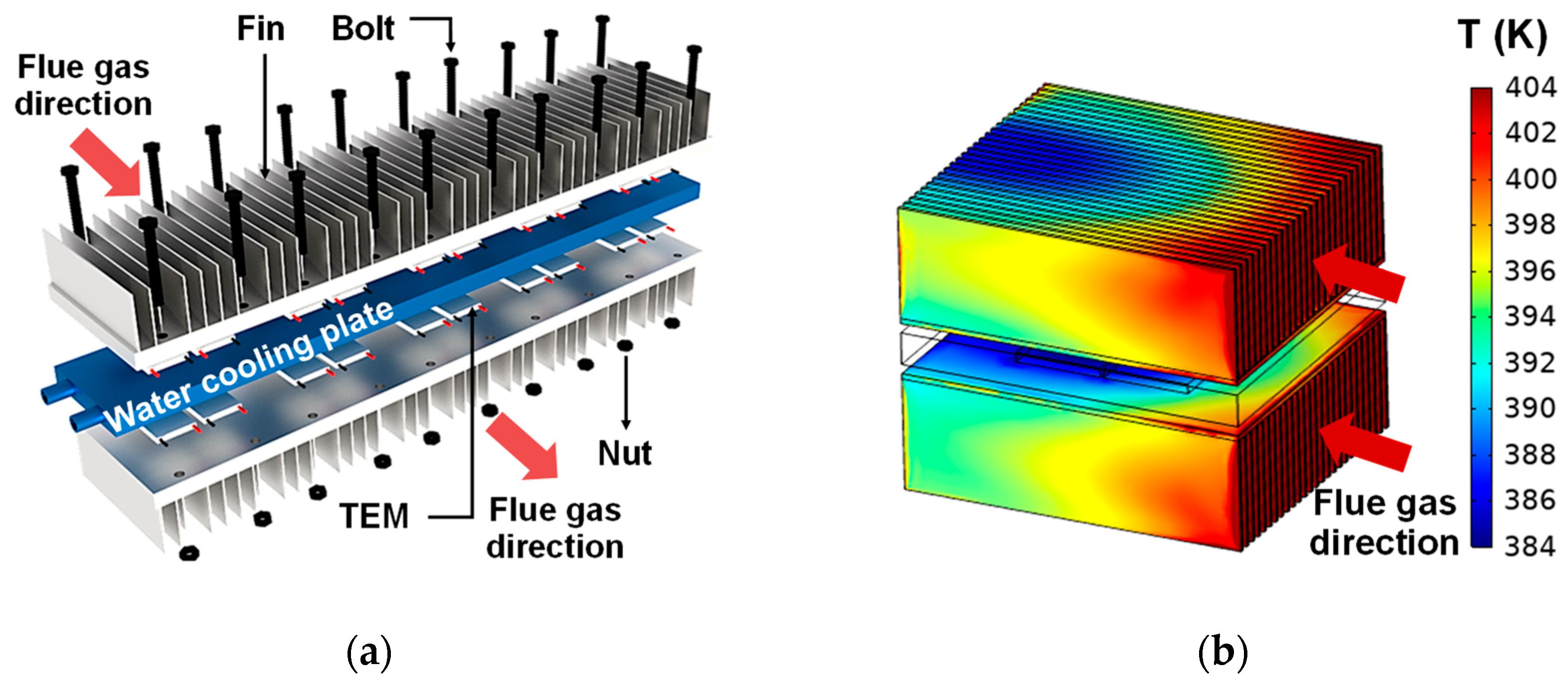

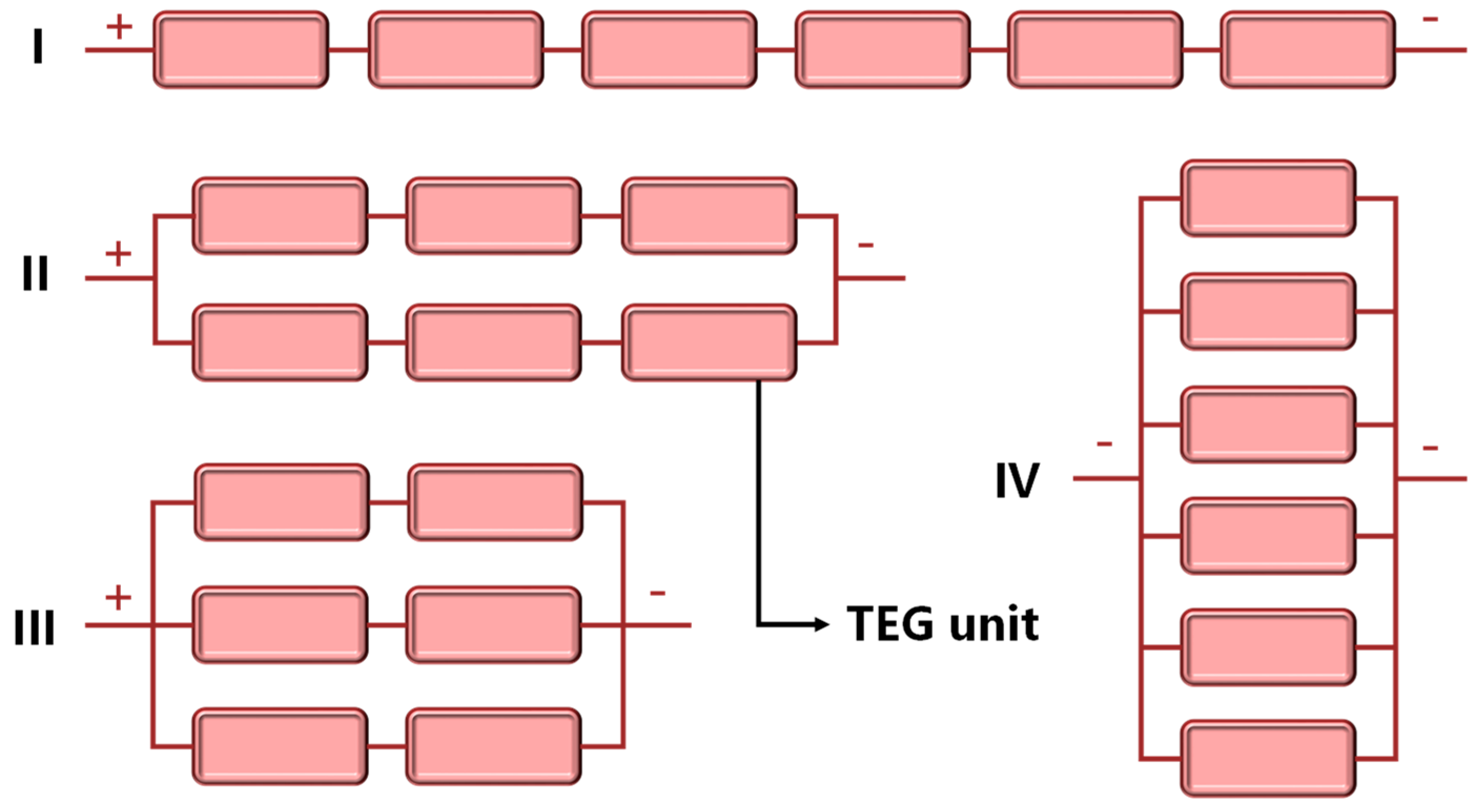
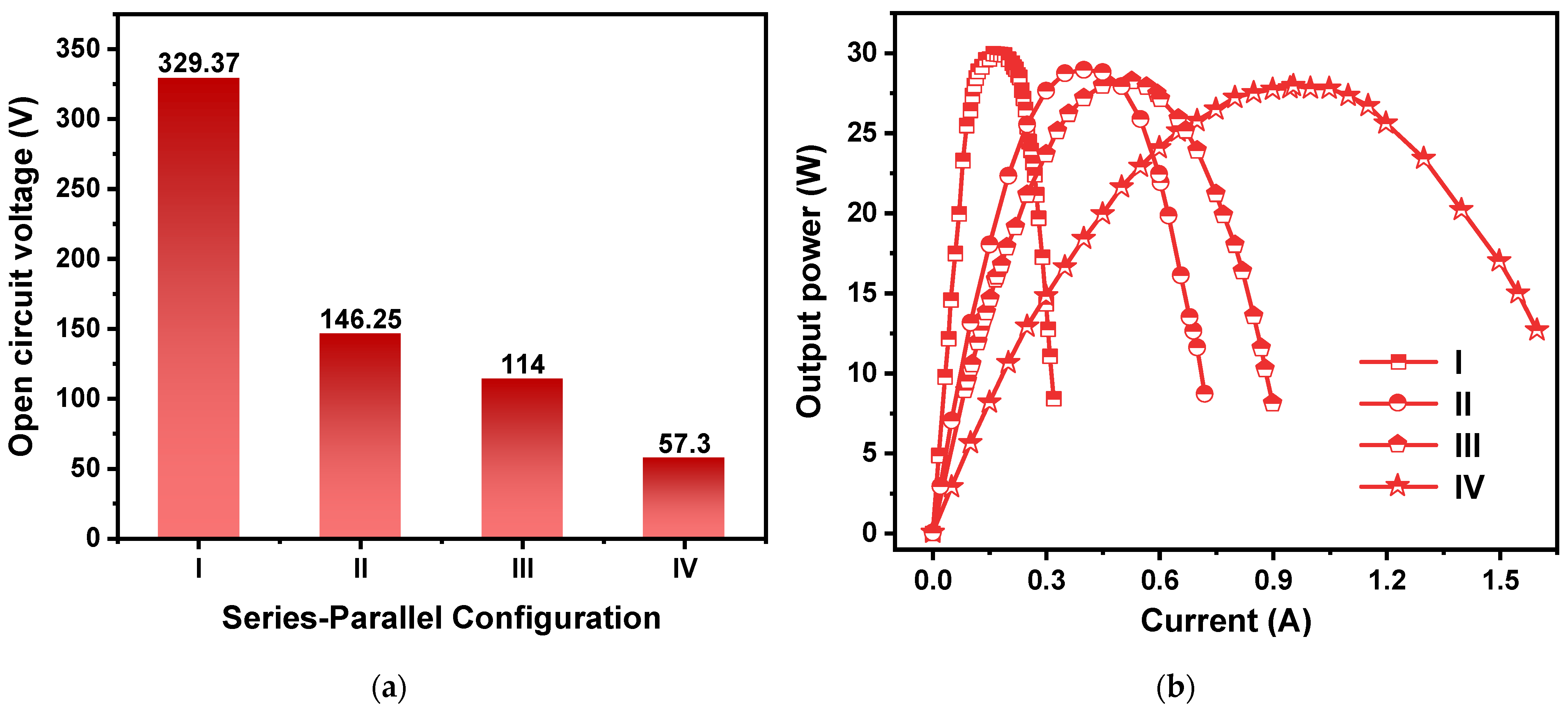
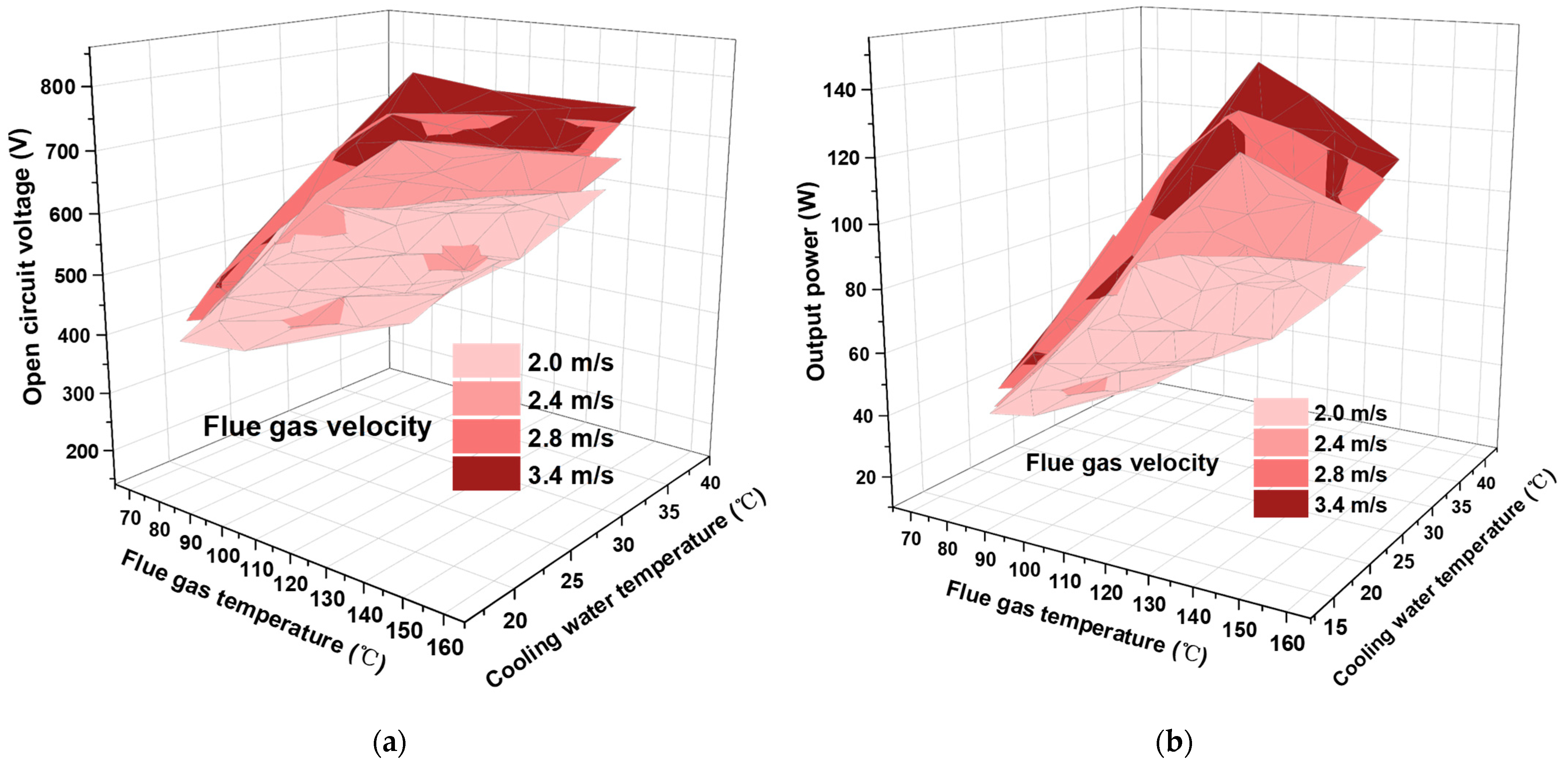
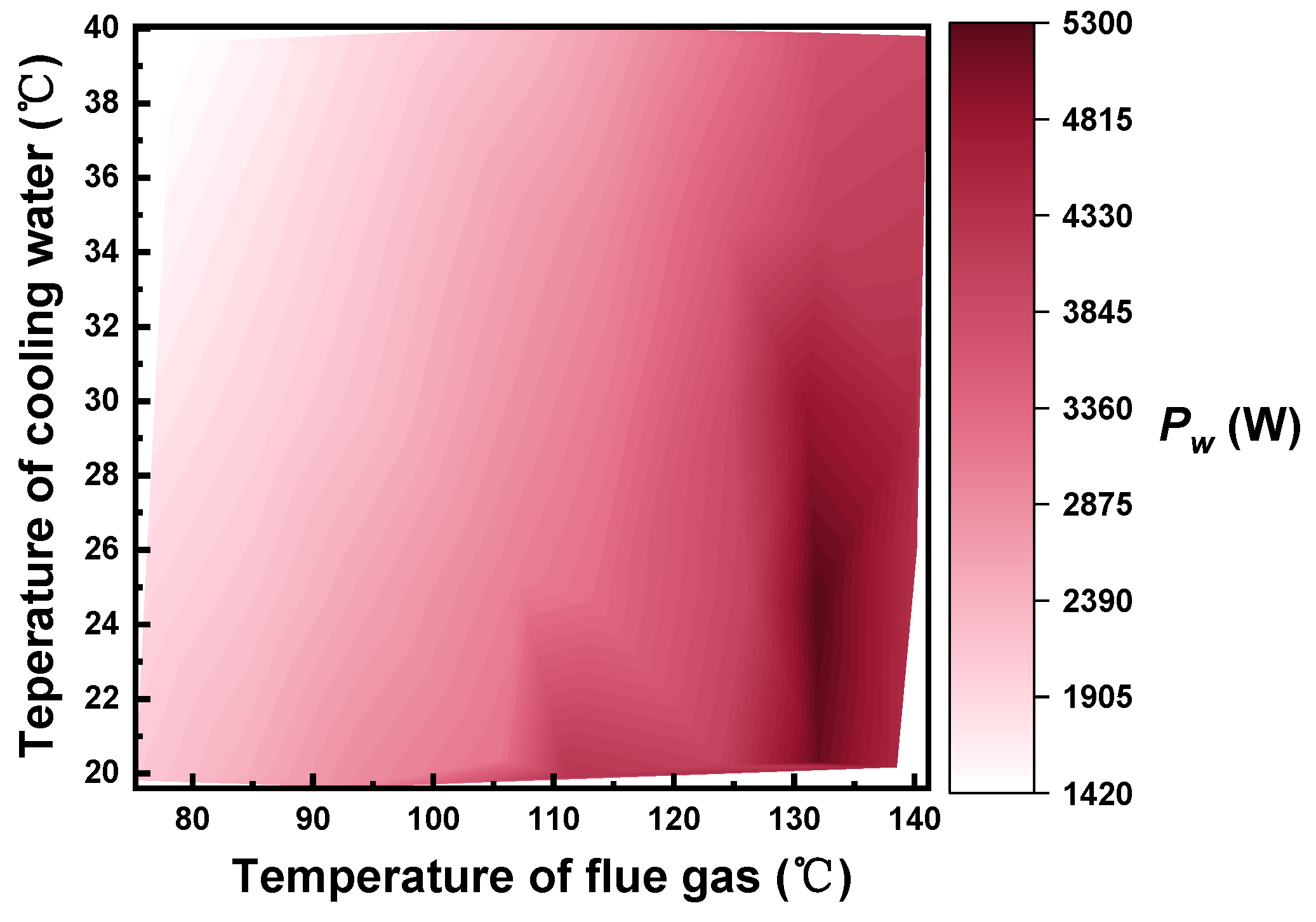

| Flue Size | Flue Gas Temperature | Flue Gas Velocity | Cooling Water Temperature | Cooling Water Flow |
|---|---|---|---|---|
| 605 mm (L) × 506 mm (W) × 435 mm (H) | 20–200 °C | 0–3.4 m/s | 5–40 °C | 0–0.743 m3/h |
| Fin Spacing | 2 mm | 4 mm | 6 mm | 8 mm | 10 mm | |
|---|---|---|---|---|---|---|
| Fin Height | ||||||
| 25 mm | 59 °C | 56 °C | 51 °C | 45 °C | 41 °C | |
| 35 mm | 66 °C | 63 °C | 57 °C | 52 °C | 47 °C | |
| 45 mm | 72 °C | 69 °C | 64 °C | 58 °C | 53 °C | |
| 55 mm | 76 °C | 73 °C | 69 °C | 63 °C | 56 °C | |
| Specifications of Single TEG Unit | 495 mm × 100 mm × 130 mm | ||||
|---|---|---|---|---|---|
| Heat Collection Structure | TEM | Water Cooling Plate | |||
| Specifications | 450 mm × 100 mm × 45 mm | Specifications | 25 mm × 25 mm × 3.5 mm | Specifications | 470 mm × 70 mm × 12 mm |
| Number | 2 | Number | 40 | Number | 1 |
Disclaimer/Publisher’s Note: The statements, opinions and data contained in all publications are solely those of the individual author(s) and contributor(s) and not of MDPI and/or the editor(s). MDPI and/or the editor(s) disclaim responsibility for any injury to people or property resulting from any ideas, methods, instructions or products referred to in the content. |
© 2024 by the authors. Licensee MDPI, Basel, Switzerland. This article is an open access article distributed under the terms and conditions of the Creative Commons Attribution (CC BY) license (https://creativecommons.org/licenses/by/4.0/).
Share and Cite
Gu, Z.; He, S.; Li, X.; Sun, P.; Wu, J.; Hu, H.; Zhang, Q.; Jiang, J. Hundred-Watt Implantable TEG Module for Large-Scale Exhaust Gas Waste Heat Recovery. Energies 2024, 17, 665. https://doi.org/10.3390/en17030665
Gu Z, He S, Li X, Sun P, Wu J, Hu H, Zhang Q, Jiang J. Hundred-Watt Implantable TEG Module for Large-Scale Exhaust Gas Waste Heat Recovery. Energies. 2024; 17(3):665. https://doi.org/10.3390/en17030665
Chicago/Turabian StyleGu, Zhien, Shi He, Xiang Li, Peng Sun, Jiehua Wu, Haoyang Hu, Qiang Zhang, and Jun Jiang. 2024. "Hundred-Watt Implantable TEG Module for Large-Scale Exhaust Gas Waste Heat Recovery" Energies 17, no. 3: 665. https://doi.org/10.3390/en17030665






